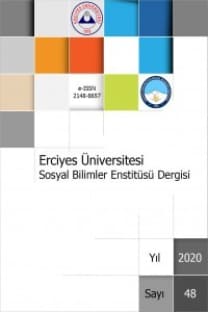DUYGUSAL ZEKA (EI) ÜZERNE FARKLI ELEŞTİRİ VE DEĞERLENDİRMELER
Duygu, Zeka, Kişilik, Gelişim, Duygusal Zeka
A REVIEW AND CRITIQUE OF EMOTIONAL INTELLIGENCE MEASURES
Emotion, Intelligence, Personality, Development, Emotional intelligence,
___
Barchard, K. A. (2003), Does emotional intelligence assist in the prediction of academic success?, Educational and Psychological Measurement, 63, 840.858.Bar-On, R. (1997), Bar-On Emotional Quotient Inventory: Technical manual (EQi). Toronto, Canada: Multi- Health Systems.
Bar-On, R. (2000), Emotional and social intelligence: insights from the Emotional Quotient Inventory (EQ-i). In R. Bar-On, & J. D. A. Parker (Eds.), Handbook of emotional intelligence (pp. 363 388). San Francisco, CA: Jossey-Bass.
Boyatzis, R. E., Goleman, D., & Rhee, K. S. (2000), Clustering competence in emotional intelligence. In R. Bar-On, & J. D. A. Parker (Eds.), The handbook of emotional intelligence: Theory, development, and assessment, and application at home, school, and in the workplace (pp. 343 362). San Francisco, CA: Jossey-Bass.
Brackett, M. A., & Mayer, J. D. (2003), Convergent, discriminant, and incremental validity of competing measures of emotional intelligence, Personality and Social Psychology Bulletin, 29, 1147 1158.
Caruso, D. R., Mayer, J. D., & Salovey, P. (2002), Relation of an ability measure of motional intelligence to personality, Journal of Personality Assessment, 79, 306 320.
Daus, C. S., & Ashkanasy, N. M. (2003), Will the real emotional intelligence please stand up? On deconstructing the emotional intelligence debate , Industrial-Organizational Psychologist, 41(2), 69 72.
Davies, M., Stankov, L., & Roberts, R. D. (1998), Emotional intelligence: in search of an elusive construct, Journal of Personality and Social Psychology, 75, 989 1015.
Dawda, D., & Hart, S. D. (2000), Assessing emotional intelligence: reliability and validity of the Bar-On Emotional Quotient Inventory (EQ-i) in university students, Personality and Individual Differences, 28, 797 812.
Goldstein, I. L., & Ford, J. K. (2002), Training in Organizations: Needs Assessment, Development, and Evaluation (4th ed.). Belmont, CA: Wadsworth.
Goleman, D. (1995), Emotional Intelligence: Why It Can Matter More Than IQ. New York: Bantam. Goleman, D. (1998), Working With Emotional Intelligence. New York: Bantam.
Gowing, M. K. (2001), Measurement of individual emotional competence, In C. Cherniss, & D. Goleman (Eds.), The emotionally intelligent workplace: How to select for, measure, and improve emotional intelligence in individuals, groups, and organizations (pp. 83 131). San Francisco, CA: Jossey-Bass.
Hunt, T. (1928), The measurement of social intelligence, Journal of Applied Psychology, 12, 317 334.
Hunter, J. E., & Hunter, R. F. (1984), Validity and utility of alternative predictors of job Performance, Psychological Bulletin, 96, 72 98.
Kaplan, R. M., & Saccuzzo, D. P. (2001), Psychological Testing: Principles, Applications, and Issues (5th ed.). Belmont, CA: Wadsworth.
Landy, F. J., & Conte, J. M. (2004), Work In The 21st Century: An Introduction to Industrial and Organizational Psychology. Boston, MA: McGraw-Hill. Matthews, G., Zeidner, M., & Roberts, R. D. (2002), Emotional Intelligence: Science and Myth. Cambridge, MA: MIT Press.
Mayer, J. D., Caruso, D. R., & Salovey, P. (1999), Emotional intelligence meets traditional standards for an intelligence, Intelligence, 27, 267 298.
Mayer, J. D., Caruso, D., & Salovey, P. (2000), Selecting a measure of emotional intelligence: the case for ability scales, In R. Bar-On, & J. D. Parker (Eds.), Handbook of emotional intelligence (pp. 320 342). New York: Jossey-Bass.
Mayer, J. D., & Salovey, P. (1993), The intelligence of emotional intelligence, Intelligence, 17, 433 442.
Mayer, J. D., & Salovey, P. (1997), What is emotional intelligence?, In P. Salovey, & D. Sluyter (Eds.), Emotional development and emotional intelligence: Implications for educators (pp. 3 31). New York: Basic Books.
Mayer, J. D., Salovey, P., Caruso, D. R., & Sitarenios, G. (2003), Measuring emotional intelligence with the MSCEIT V2.0, Emotion, 3, 97 105.
Murphy, K. R., & Davidshofer, C. O. (2001), Psychological Testing: Principles and Application (5th ed.). Upper Saddle River, NJ: Prentice-Hall.
Newsome, S., Day, A. L., & Catano, V. M. (2000), Assessing the predictive validity of emotional intelligence, Personality and Individual Differences, 29(6), 1005 1016.
Roberts, R. D., Zeidner, M., & Matthews, G. (2001), Does emotional intelligence meet traditional standards for an intelligence? Some new data and conclusions, Emotion, 1, 196 231.
Sala, F. (2002), Emotional Competence Inventory: Technical manual. Philadelphia, PA: McClelland Center For Research, HayGroup.
Salovey, P., Mayer, J. D., Caruso, D., & Lopes, P. N. (2003), Measuring emotional intelligence as a set of abilities with the Mayer Salovey Caruso Emotional Intelligence Test, In S. J. Lopez, & C. R. Snyder (Eds.), Positive psychological assessment: A handbook of models and measures (pp. 251 265). Washington, DC: American Psychological Association.
Schmidt, F. L., & Hunter, J. E. (1998), The validity and utility of selection methods in personnel psychology: practical and theoretical implications of 85 years of research findings, Psychological Bulletin, 124, 262 274.
Slaski, M., & Cartwright, S. (2003), Emotional intelligence training and its implications for stress, health, and performance, Stress and Health, 19, 233 239.
Slaski, M., & Cartwright, S. (2002), Health, performance, and emotional intelligence: an exploratory study of retail managers, Stress and Health, 18, 63 68.
Thorndike, R. L. (1936), Factor analysis of social and abstract intelligence, Journal of Educational Psychology, 27, 231 233.
Thorndike, R. L., & Stein, S. (1937), An evaluation of the attempts to measure social ntelligence, Psychological Bulletin, 34, 275 285.
Van Rooy, D. L., & Viswesvaran, C. (2004), Emotional intelligence: a meta- analytic investigation of predictive validity and nomological net, Journal of Vocational Behavior, 65, 71 95.
- Yayın Aralığı: Yılda 2 Sayı
- Yayıncı: Erciyes Üniversitesi
BURHAN CAHİT MORKAYA’NIN “İNKILÂP SEtâSİ” GENEL BAŞLIĞIYLA YAYIMLANAN BEŞ ESERİ
MÜZİK KURAMCISI VE EFSANEVİ KİŞİLİK OLARAK SAFİ YYÜDDÎN-1 URMEVİ
CİNSİYET AYRIMINA DAYALI BİR TOPLUMDA BİR YABANCI DİLİN KULLANIMBİLİMSEL FARKINDALIĞI
AN APOLOGY FOR POESY VERSUS ASTROPHIL AND STELLA BY SIR PHILIP SIDNEY
İSTANBUL’DA BİR JAPON TARHÇİ- TOKUTOMI SOHÖ’NUN MEKTUPLARINDA ON DOKUZUNCU YÜZYIL TÜRKİYE İMGELER
OKUMAYI NASIL SEVDİLER? ÜNİVERSİTE ÖĞRENCİLERİ İLE MÜLAKATLAR
TÜRK ÖĞRENCİLERİN JAPON KÜLTÜRÜNE İLİŞKİN ALGILAMALARI
ÜNİVERSİTE GENÇLİĞİNDE MARKA-TÜKETİM BAĞLAMINDA BİLİNÇ-BİLİŞ DÜZEYİ
DUYGUSAL ZEKA (EI) ÜZERNE FARKLI ELEŞTİRİ VE DEĞERLENDİRMELER
XIX. YÜZYILDA ERMENİ MİLLİYETÇİLİĞİNİN DOĞUŞUNDA MİSYONERLİK FAALİYETLERNİN ROLÜ KAYSERİ ÖRNEĞİ
